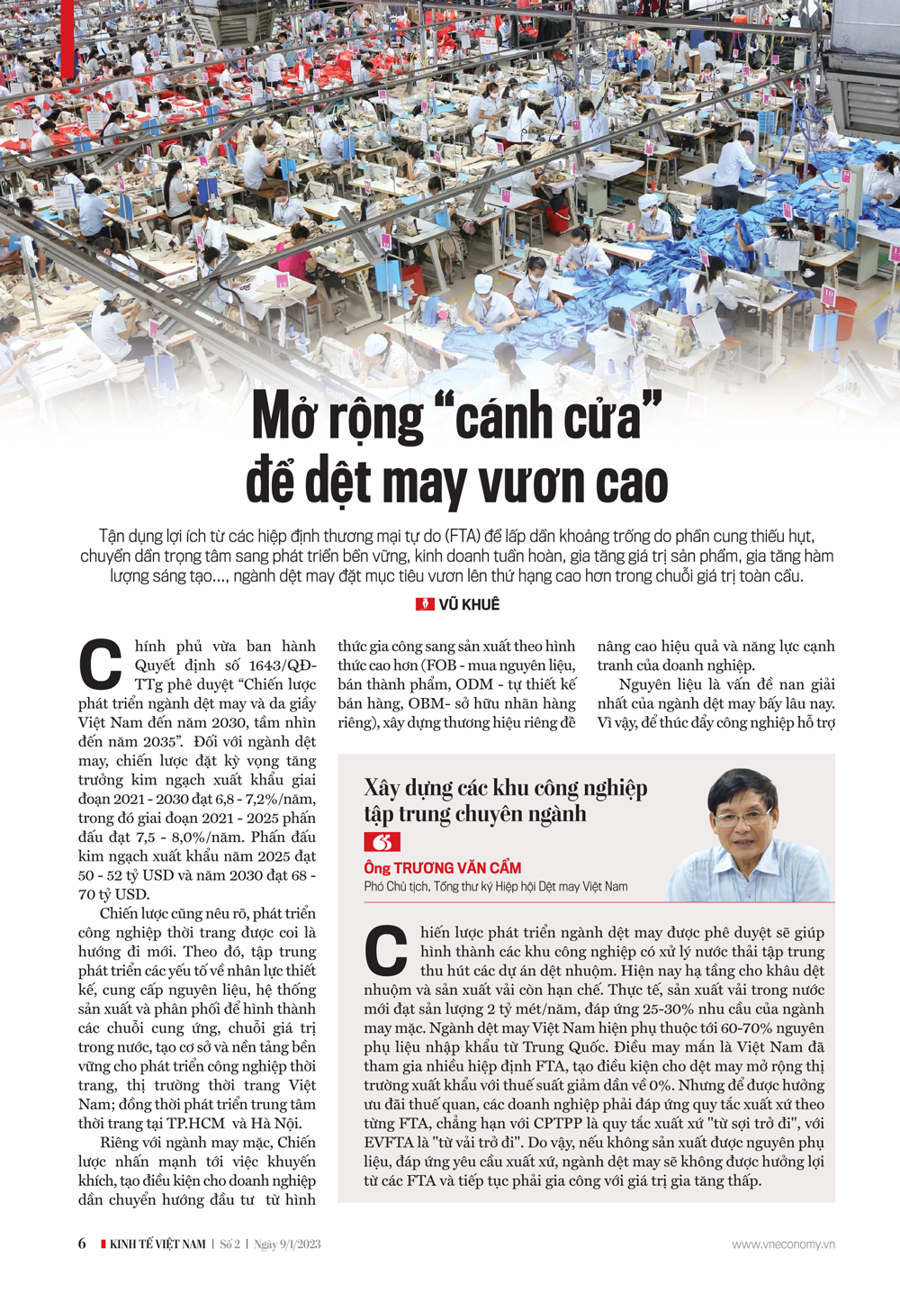[ad_1]
The government just issued Resolution No. 1643/QD-TTg approving the “Strategy for the Development of Vietnam’s Textile, Garment and Footwear Industry by 2030 with a Vision by 2035”.
For the textile and apparel industry, the strategy sets the expectation that the export sales growth will reach 6.8-7.2%/year in the period 2021-2030, of which the period 2021-2025 is targeting 7.5-8.0% will. /Year. Striving for export sales of USD 50-52 billion in 2025 and USD 68-70 billion in 2030.
The strategy also states that the development of the fashion industry is seen as a new direction. Accordingly, it focuses on developing the elements of the design of human resources, raw material supply, production and distribution systems to form supply chains, domestic value chains and to lay sustainable foundations and foundations for the development of the fashion industry and Vietnamese fashion market; and development of fashion centers in Ho Chi Minh City and Hanoi.
The strategy emphasizes the promotion and creation of conditions for companies to gradually shift their investments from outsourcing to higher production (FOB – purchase of raw materials, semi-finished products, ODM – own design and sale). Brand, OBM – owning a private label ), building a private label to improve the efficiency and competitiveness of the company.
Raw materials have long been the most difficult problem facing the textile industry. Therefore, in order to promote the development of the textile and apparel industry, according to the strategy, the textile and apparel industry aims for the localization rate of the industry to reach 51%-55% in the period from 2021 to 2025, and more in the period 2026 – 2030 56% – reach 60%.
In order to achieve this goal, it is necessary to attract investment in the development of supporting industries and products from raw materials and accessories for the textile and clothing industry on the basis of taking full advantage of the international trade agreements signed by Vietnam.
At the same time, the direction of supporting industrial projects, production of raw materials and auxiliary materials will focus on development in areas with a high density of textile and garment enterprises such as towns in the southeast region (Binh Phuoc, Tay Ninh, etc.). ., Ba Ria-Vung Tau), Red River Delta (Hung Yen, Nam Dinh, Thai Binh) and some central provinces (Thanh Hoa, Thua Thien-Hue, Quang Nam, Quang Ngai, Binh Dinh) to reduce transportation costs reduce, lower product cost and improve competitiveness.
In particular, promote the development of textile, dyeing and ancillary industries. Gradually increase the localization rate of the textile and apparel industry to improve production efficiency and maximize the benefits from free trade agreements. Investing in strongly developing knitted and woven products capable of connecting yarn and garment production stages.
Also in this period, the textile and garment industry needs to establish a number of large specialized textile and garment industry zones (including yarn weaving dyeing and fabric finishing chains) to improve and develop the weakest stage of the textile industry soon Vietnamese garment today.
To achieve this, the strategy emphasizes the role of state administrative bodies in prioritizing companies for investments in fiber, yarn, weaving, dyeing … with guidelines to encourage and create conditions for investors and companies to develop investment projects with advanced technology, who do not have any adverse impact on the environment and have ties to domestic apparel companies, creating a chain of links around the world.
The approved textile and apparel development strategy will help form industrial parks with centralized wastewater treatment to attract textile and dyeing projects. Currently, the infrastructure for textile dyeing and fabric manufacturing is still limited.
In fact, domestic fabric production reaches only 2 billion meters per year, covering 25-30% of the garment industry’s demand. Vietnam’s textile and clothing industry currently depends on 60-70% of raw materials imported from China. Fortunately, Vietnam has joined many free trade agreements, creating conditions for textiles and clothing to expand export markets, gradually reducing the tax rate to 0%.
However, in order to benefit from tariff preferences, companies must comply with the rules of origin under each FTA, for example CPTPP is the rule of origin “from the yarn” and the EVFTA is “from the fabric”. Therefore, if it is not possible to produce materials and accessories that meet the origin requirements, the textile and clothing industry does not benefit from free trade agreements and must continue to process with low added value.
In some markets today, customers are changing their perception from “fast fashion” to sustainable fashion to circular business. In particular, they fear that supply chains will have to be traced back to labor and environmental standards.
The development strategy of the textile and clothing industry is also geared towards this, and by 2030 the industry will gradually shift its focus to sustainable development and the circular economy. From 2030 to 2045, develop effectively and sustainably according to the circular economy model.
Therefore, politics must create conditions for companies to invest in scientific research and apply advanced technologies in production. Check existing specialized centers and laboratories. Invest in improving the potential of centers and laboratories at specialized research institutes to have the capacity to research and verify the quality of internationally recognized products with an emphasis on safety criteria and ecology.
Formulate and disseminate mechanisms and policies to encourage the import of source technology, high technology and clean technology in the textile and garment industry. Stimulate and encourage enterprises to invest in new machinery, equipment and technology to reduce energy consumption and sanitation, to help enterprises recover initial investment costs and improve product competitiveness. The strategy emphasizes respect for green and clean standards for textile products from raw material to finished product.
Vietnamese garment companies have a large processing capacity, the raw materials are about 65% from imported sources. This is the biggest obstacle to the development of the textile industry today.
The content of the article was published in Vietnam Economic Review No. 02, published on January 9, 2023. Welcome readers to read This:
https://postenp.phaha.vn/chi-tiet-toa-soan/tap-chi-king-te-viet-nam

[ad_2]
Source link

